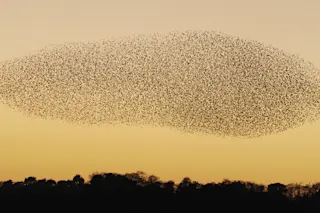Birds in a flock, darting and swooping in synchrony, display skillful precision in their collective motion. Now a group of physicists has coaxed flocking behavior out of a completely lifeless system — a collection of tiny brass rods and spherical beads on a vibrating plate.
Researchers from the Indian Institute of Science in Bangalore had studied the physics of such rods for years. They focused their efforts on producing flocking after taking inspiration from research on locusts, which align in flocks only when crammed together above a certain density.
A single layer of millimeter-size, tapered, brass rods aligns spontaneously on a vibrating surface amid a background of aluminium beads. The plate’s flower shape helped perpetuate the flow of the rods among the beads, revealing the underlying physics. (Credit: Ajay Sood/Indian Institute of Science)
Ajay Sood/Indian Institute of Science
The same phenomenon, the researchers thought, might be observable with the rods. ...















